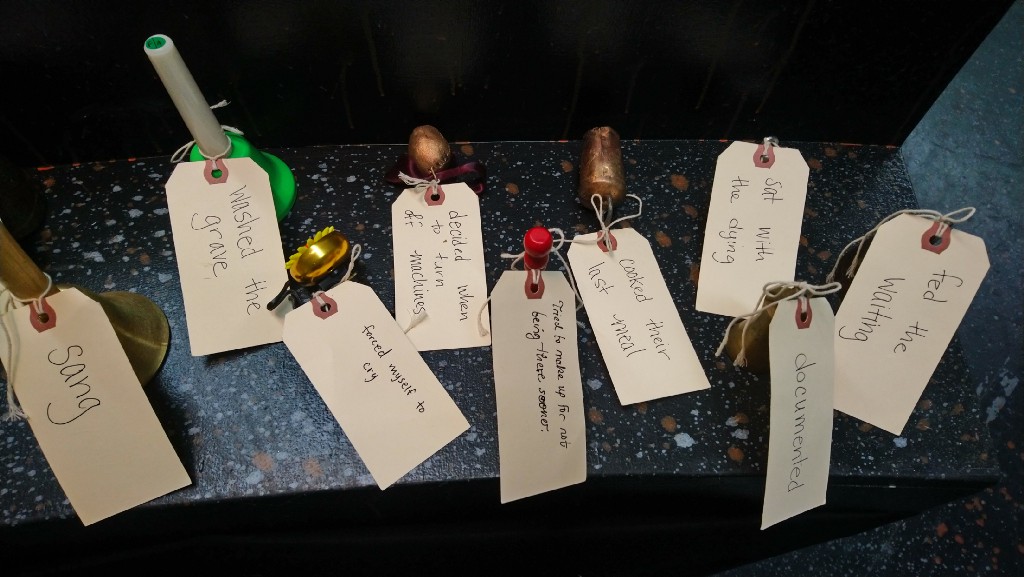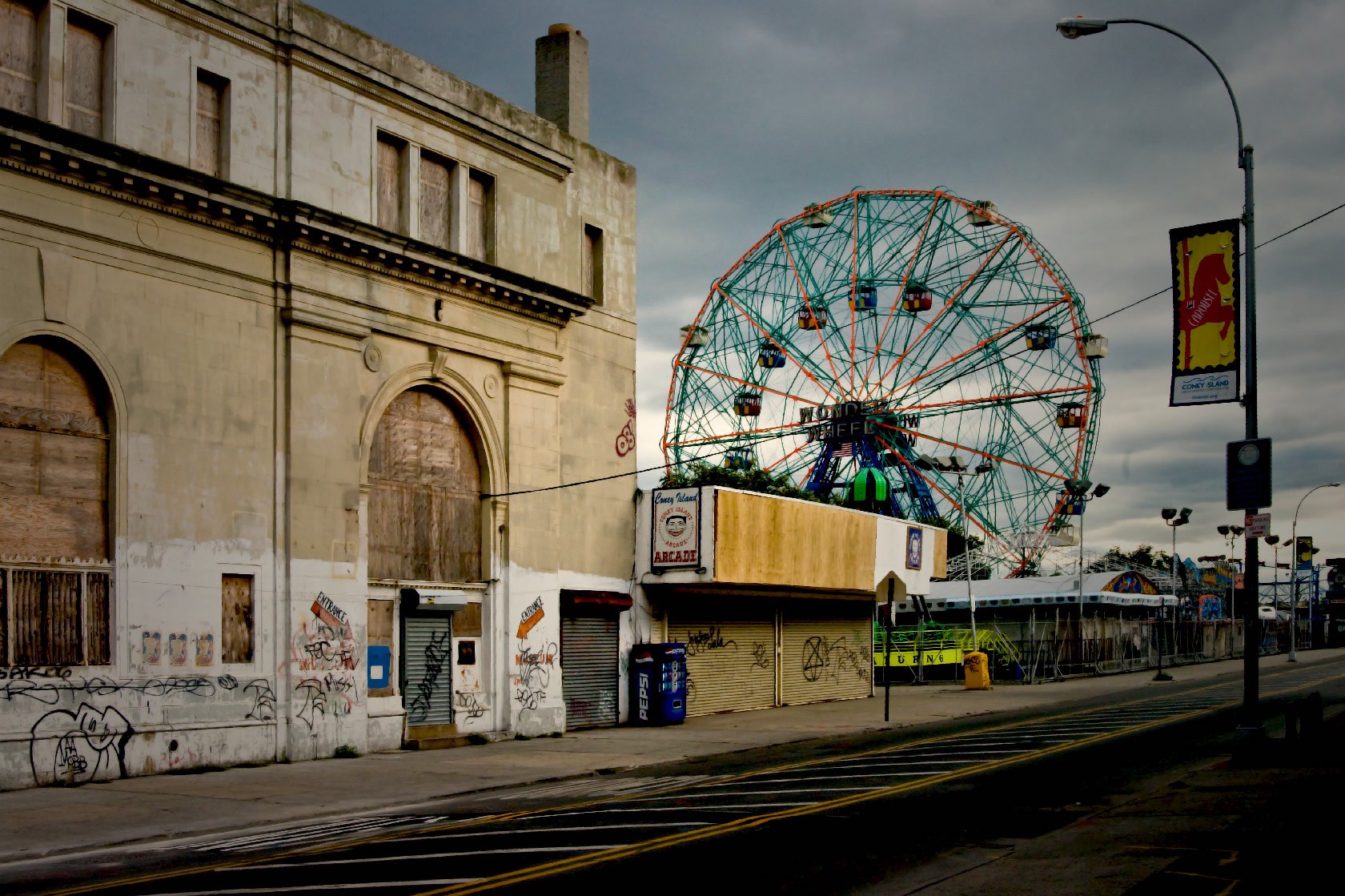Books & Culture
A New Art Festival Aims to Change the Way We Tell Stories About Grief
Good Mourning wants to give people a more functional narrative for grieving

“Everything is sad here. I am excited, but I am weird,” says Casey Middaugh, the artist and founder of Good Mourning, an interactive arts festival about grief and loss. As newly-arrived festival-goers trickle in on opening night she walks with them past an installation of bells, along panels from the NAMES Project’s AIDS memorial, past a floor-to-ceiling-length Human Body Quilt, and towards a cardboard coffin, the kind used in cremation ceremonies, part of the “Arts & Casket” installation.
Scrawled in magic marker ink along the side of the cardboard coffin are the statements like “I am still processing how to be alive every day” and “Why does everything I love leave me?” These are heavy sentiments to ponder for a leisurely weeknight outing. But the overall vibe, banter, and sense of community in the air is decidedly light and festive, yet never shallow or disrespectful. Something else: inviting and liberating.
These are heavy sentiments to ponder for a leisurely weeknight outing. But the overall vibe, banter, and sense of community in the air is decidedly light and festive.
And, yes, a little weird. Death is still a cultural taboo, pathologized perhaps even more so than sex. Stories of death — from the recent Camp Fire in California to the shootings of unarmed black people — are all around us. Yet, death’s aftermath and the grief journey which follows is hidden from plain sight. Grief itself is presented as a neatly packaged story with five easy-to-progress-through stages and primarily experienced for a few weeks following a funeral.
It isn’t surprising, then, that most of us don’t know where or how to start telling the story of our grief, or know the best ways to support our friends and family who are experiencing loss themselves. That’s the idea behind Good Mourning. The festival highlights projects across a spectrum of storytelling options — music, visual arts, performance, games — to offer different ways to contextualize and navigate loss.
Storytelling plays a key role in making grief more manageable. “You must get it out,” author Elizabeth Kubler-Ross writes in On Grief and Grieving, continuing, “Tell your tale, because it reinforces the loss mattered.” No story is too unorthodox or off limits. Good Mourning’s programming reflects this. From the Advance Directive Disco to the “Losing It” comedy show to the “How to Be a Good Grief Ally” workshop, the breadth and depth of artistic mediums employed speak to people all along the grief spectrum. Three exhibits in the gallery serve as a sampling for how the artists involved tell the story of their own journey with grief, exploring both personal and cultural losses, while giving others the tools and words to help them do the same.
It isn’t surprising that most of us don’t know where or how to start telling the story of our grief.
A common thread in many grief stories — particularly in the early days following a loss — center on the daily reminders and small indignities suffered closing out someone’s life, like wrangling with customer service reps shutting off a deceased friend’s electricity. Good Mourning organically grew out of Middaugh’s foundational exhibit, For Whom the Bell Toils, and gives people an unusual way to sound off about these moments.
Following the loss of her grandfather, she realized how overwhelmed she was with the mental and emotional labor that goes into closing out the practical affairs of a person’s life. Yet, no matter how many items she crossed off this un-enviable to-do list, she says, “I couldn’t make things right” — bring back her grandfather, or ultimately heal her grandmother’s heartbreak.
Still, she wanted to make manifest her grieving process. Thinking through what physical mediums would make death work feel seen and heard led her to bells. She explains, “Most people are familiar with bells, they are remarkably easy to find at thrift stores, and the idea that you can ring the melody of your grief appealed to me.”

For the exhibit, more than 130 bells of all shapes and sizes are set up along a table and multi-tiered shelf. Each bell is assigned a label indicative of death and grief’s emotional labor. Things like “clipped toenails,” “wiped the blood off my spouse’s shoes, “cared for grieving children,” “filed taxes for the deceased,” “write the obituary,” and “mediated family conflict.” For the last one, sleigh bell door hangers are the bells of choice as they contain numerous bells attached to a leather strip; no matter how you pick them up, more than one bell rings at once. The bells allow people to express their grief individually but do so communally.
As people move through the gallery, they choose the bell with the experience they find most resonant, pick it up and let it ring. This isn’t a chorus of bells playing in unison. In this way, the bells are representative of the unpredictability of grief itself, which is rarely, if ever in sync with the rest of our lives.
Elise Bernal’s Human Body Quilt tells the story of how grief, loss, and heartbreak live in our bodies. Unprocessed grief can wreak havoc on our mental and physical health. Stress cardiomyopathy, known as “broken heart syndrome” is a medical condition in which grief mimics the symptoms of a heart attack.

“What part of your body needs to heal?” is the prompt leading up to the quilt. Each body part in Bernal’s quilt contains an item relating that part of the body to a resource or inspiring note. A zine called Cancer Care lives in the breast pockets. It shares resources and support for those experiencing cancer in their family. This related to her mom’s breast cancer and the difficulty of finding resources, eating better, and dealing with mental health challenges.
“I lost my Mom in February of this year, and the days and months after have been eye-opening,” she told me. “I learned so much about patience, acceptance, love, and so much about her strength and my strength. The piece became a way to showcase those learning experiences.”
Bernal’s zine is a beautiful art form unto itself, both the language and original drawings. She depicts a scene from the first time she visited her mother’s grave laying down on top of it. What do love and connection mean beyond death? Bernal writes, “I felt her presence free from everything except the earth. In a sense, there is new life in all the feelings and processes, though heavy, scary, and sad, in this process of loss.”
There is no one right way to grieve, nor is mourning limited to only loss of life scenarios. Good Mourning’s Living Room Exhibit designed by Michael B. Maine tells the story of mourning born of cultural and systemic struggle.
Maine replicates the living room of a typical black family in America. It includes the usuals: couch, coffee table, bookshelves, and record player, but with an impossible to miss caveat. A new burial plot replete with a mound of fresh dirt present where you might expect a rug or loveseat to go.
“Throughout the years, it’s been difficult for me to feel like I belong in this world when it seems as though most of the messages I receive suggest that perhaps I don’t,” Maine told me. “In thinking about this seemingly systematic and intentional erasure of blackness, I began to mourn the things that wouldn’t exist without black people.”
The Living Room serves as physical space for participants to hang out in, but also to connect more deeply with contributions from black artists. Vinyl records — everything from classics like Lena Horne to modern day Kendrick Lamar — are on the window sill ready for a listen. Books by the likes of Octavia Butler and James Baldwin line the bookshelves.

Every hour during regular gallery hours, a work of art from a black luminary is buried. When I asked about his motivation for this piece, Maine said, “This project is about the celebration of the fact that we exist. Through all the trauma, successes, failures, experiments, and what often feels like insurmountable odds, we are still here. I think about the huge cultural, technological, and economic impacts that black people have made throughout history. What if none of those people existed and none of those impacts were realized?”
Admittedly, sitting in a living room with a burial plot, at least initially, evokes unsettling feelings. Over the course of an evening, however, while you read Butler, Bee’s zines on hand, or chat with other festival-goers, the plot fades (sort of) into the background. It drives home a central point most of us spend considerable effort avoiding: death is a normal part of everyday life. Telling our individual and collective stories of grief and loss doesn’t have to be so weird.









